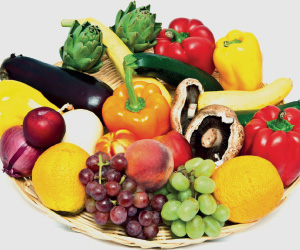Wondering what’s causing your stomach to balloon? Liezel Joubert spoke to two experts
 Artificial sweeteners
Artificial sweeteners
Because your body only partially breaks down and absorbs these sweeteners, they can serve as food for gas-producing bacteria in your digestive tract if they are consumed in excess. Sorbitol, xylitol and isomalt are some of the names you will recognise on labels.
Ditch it It can be difficult to cut out all artificial sweeteners, because they are found in virtually everything that is labelled low-fat or sugar-free. You can reduce your intake, though, by opting for cocoa nibbles (avoid low-kilojoule sweets) and drinking water with lemon and mint rather than diet fizzy drinks (which can also cause weight gain).
Refined carbs and sugar
Refined carbs, like those found in breakfast cereals, pastries and other baked goods, get broken down into sugar (glucose) in your body. Excessive consumption of sugar and carbs creates an overload of glucose in your system, which can lead to trouble absorbing all these sugars. This is a common cause of bloating, as these sugars also act as food for your gut flora.
Ditch it Cut down by reading labels and limiting chocolates, sweets and other obvious forms of sugar. And remember, sugar goes by different names, such as high-fructose corn syrup, honey, fruit juice concentrate, fructose and molasses.
Fibre
Fibre plays a vital role in a healthy digestive system, as it’s not absorbed or broken down completely by your body’s digestive enzymes in the small intestine, which makes it perfect for facilitating the transport of food.
Soluble fibre is especially good, as it sticks to cholesterol and helps with removing it from your body. However, it is this same good quality that can also cause bloating and cramping if it ferments in the large intestine.
Ditch it Watch your intake of things such as bananas, garlic, onion, leeks, artichokes, barley and wheat, as well as other sources of fibre such as oats, pulses and legumes. And ensure you drink extra water to assist in flushing the fibre out of your system.
Dried fruit
These contain a lot of fructose that many people’s systems struggle to absorb (see ‘Fodmap Food List’ below), which means it’ll hang around in your body, serving as food for gas-forming gut bacteria.
Ditch it Try a few raw nuts or biltong when you next have a snack attack.
Salt
This seasoning staple causes our bodies to retain water, so if you eat too much of it, your kidneys will struggle to get rid of it fast enough. It can also cause other big problems, like hypertension. A much less serious, but still rather uncomfortable, side effect is bloating. Most people do not realise just how much salt they ingest, because it is hidden in many processed foods. According to The Heart and Stroke Foundation South Africa, it is estimated that South Africans eat between six and 11g of salt per day. The recommended amount is five grams.
Ditch it Try to steer clear of bottled sauces, canned soup, salad dressings and processed meat – and of course the more obvious culprits, such as chips and popcorn. Use healthier alternatives to flavour your food, such as fresh or dry herbs and spices, and lemon juice.
FOD-WHAT?
If after eliminating the common culprits, you still struggle with bloating and also regularly experience cramps, diarrhoea and constipation, you may have a bigger problem on your hands, namely food sensitivity.
Adrian Penzhorn, registered dietitian at Food for Sport, says many people who struggle with bloating may be sensitive to a list of food labelled as Fodmaps (fermentable oligo-, di-, mono-saccharides and polyols). It sounds complicated, but it’s basically a group of foods that contains undigestible carbohydrates.
‘When these foods move into the small intestine, it can result in diarrhoea, or as they move into the large intestine, they act as a food source for bacteria living there, which, after fermentation, results in an increased amount of gas being produced and subsequently, pain, bloating, distension, flatulence or constipation.’
If you’re serious about de-bloating, Adrian suggests an elimination diet. ‘Cut out all Fodmaps for two to six weeks while monitoring your symptoms. After a six-week elimination diet, these foods should be reintroduced gradually to assess your tolerance, including one new food every two days, with an assessment period of another one to two days. Start with the foods you struggled to cut out or missed the most.’
If the problems persist, it may be best to consult your GP.
FODMAP FOOD LIST
Sources of oligosaccharides
Nectarines
White peaches
Watermelon
Artichoke
Chicory
Garlic (and garlic powder)
Leek
Onion (and onion powder)
Spring onion (the white part)
Barley
Wheat (including rye)
Chickpeas
Legume beans (baked beans, kidney beans, borlotti beans)
Lentils
Pistachios
Cashews
Sources of disaccharides
Custard
Condensed milk
Dairy desserts
Evaporated milk
Ice cream
Milk (and milk powder)
Unripened cheese (ricotta, cottage, cream, mascarpone)
Yoghurt
Sources of fructose
Apples
Figs
Mango
Pear
Watermelon
Asparagus
Artichokes
Sugar snap peas
Fruit juices
Dried fruit
High-fructose corn syrup
Honey
Sources of polyols
Food sweetened with polyols (or sugar alcohols – isomalt, maltitol, mannitol, sorbitol, xylitol)
Most stone fruits (apricots, cherries) contain trace amounts
Give it a rest
Dietitian Cheryl Meyer suggests the following when trying to drop those extra kilos:
• Have a good-sized breakfast and eat regularly
• Eat slowly and chew your food well
• Exercise regularly
• Lactose can cause wind and bloating. Try lactose-free cow’s milk and yoghurt for two weeks to see if it makes a difference
• Try probiotic supplements, yoghurt or fermented milk drinks daily for four weeks.
Useful contacts
Adrian Penzhorn
adrian@foodforsport.co.za
Cheryl Meyer
cherylmeyerrd@gmail.com







